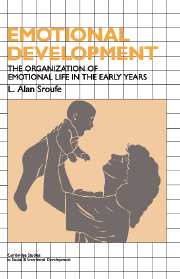Book contents
- Frontmatter
- Contents
- Preface
- Part I The nature of emotional development
- Part II The unfolding of the emotions
- Part III Emotional development and individual adaptation
- 9 The social nature of emotional development
- 10 Attachment: the dyadic regulation of emotion
- 11 The emergence of the autonomous self: caregiver-guided self-regulation
- 12 The growth of self-regulation
- 13 Summation
- References
- Index
11 - The emergence of the autonomous self: caregiver-guided self-regulation
Published online by Cambridge University Press: 16 September 2009
- Frontmatter
- Contents
- Preface
- Part I The nature of emotional development
- Part II The unfolding of the emotions
- Part III Emotional development and individual adaptation
- 9 The social nature of emotional development
- 10 Attachment: the dyadic regulation of emotion
- 11 The emergence of the autonomous self: caregiver-guided self-regulation
- 12 The growth of self-regulation
- 13 Summation
- References
- Index
Summary
A positive, reciprocal interpersonal set between parent and child, which renders the child ready, receptive, and positively motivated to respond to parental socialization … and internalize parental standards and values may be the result of a long-term positive relationship.
Kochanska (1993)The psychobiological state of shame distress represents a sudden shift from sympathetic-predominant … to parasympathetic-dominant trophotropic arousal … The caregiver influences the parcellation of the two limbic circuits … and thereby the permanent excitation–inhibition (autonomic) balance of his prefrontolimbic regulatory system.
Schore (1994)Impressive development occurs in the years just after infancy, development that again is characterized by qualitative change and transformation. Major changes include the advent of symbolic representation and language, self-awareness, and the beginnings of self-control. Yet despite the profound changes that occur during this period, the same principles that governed development in infancy are again apparent. Development is unified and orderly, building on what was previously present yet moving to progressively new levels of complexity.
The overarching socioemotional task for the preschool years is the movement from dyadic regulation toward the self-regulation of emotion. In keeping with the nature of all development, there is a succession of phases in accomplishing this task. As regulation orchestrated by the caregiver prepared the way for more truly dyadic regulation in infancy, so too there is a transition here, wherein self-regulation supported and guided by caregivers precedes regulation by the child outside of the caregiving matrix.
- Type
- Chapter
- Information
- Emotional DevelopmentThe Organization of Emotional Life in the Early Years, pp. 192 - 213Publisher: Cambridge University PressPrint publication year: 1996



